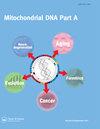Genetic structure and historical demography of the blue swimming crab (Portunus pelagicus) from southeastern sea of China based on mitochondrial COI gene
IF 0.6
4区 生物学
Q4 GENETICS & HEREDITY
引用次数: 12
Abstract
Abstract In this study, the population genetic structure and historical demography of the blue swimming crab, Portunus pelagicus, from southeastern sea of China were investigated using cytochrome c oxidase subunit I (COI) gene of mitochondrion. A total of 889 bp segment of COI gene was sequenced, which showed a high haplotype diversity (0.6833–0.8142) and low nucleotide diversity (0.0021–0.0034). Among 30 haplotypes defined in this study, one (H1) was the most dominant (47.7%) and shared by each locality, while the majority (23) were rare and only existed in one individual. The AMOVA analysis revealed a limited population genetic structure, which suggested a high level of gene flow along the distribution areas of China. This conclusion was supported by the pairwise FST comparison values. The topology of the neighbour-joining tree constructed using 30 haplotypes from four localities presented two distinct clades (clade A and clade B). Meanwhile, three sequences of P. pelagicus downloaded from NCBI database showed a high-level divergence with the individuals collected in our study, which might form a new cryptical species. The individuals of clade B were cryptically embedded in the whole population, with a low frequency (7.7–24.2%), while clade A accounted for 75.8–92.3%. Neutrality tests and mismatch analyses suggested a late Pleistocene population expansion for both clade A (47,000–66,000 years ago) and clade B (74,000–100,000 years ago). This study should provide insight into phylogeny, population genetic structure, conservation genetics, and sustainable management of P. pelagicus.基于线粒体COI基因的中国东南海域蓝蟹遗传结构及历史人口学分析
摘要本研究利用线粒体细胞色素c氧化酶亚基I (COI)基因对中国东南海域蓝蟹(Portunus pelagicus)种群遗传结构和历史人口学进行了研究。COI基因全长889 bp,单倍型多样性高(0.6833-0.8142),核苷酸多样性低(0.0021-0.0034)。在本研究定义的30个单倍型中,有1个(H1)是最显性的(47.7%),由每个地方共享,而大多数(23)是罕见的,只存在于一个个体中。AMOVA分析显示种群遗传结构有限,表明沿中国分布区域存在高水平的基因流动。这一结论得到了FST两两比较值的支持。利用来自4个地点的30个单倍型构建的邻居连接树拓扑结构呈现出两个不同的分支(A和B)。同时,从NCBI数据库中下载的3个pelagicus序列与本研究中收集的个体表现出高度分化,可能形成一个新的神秘物种。B支系的个体在整个种群中隐嵌,频率较低(7.7 ~ 24.2%),而a支系的个体占75.8 ~ 92.3%。中性测试和不匹配分析表明,进化支a(47,000-66,000年前)和进化支B(74,000-100,000年前)在更新世晚期都有种群扩张。本研究将为深入了解青鱼的系统发育、种群遗传结构、保护遗传学和可持续管理提供理论依据。
本文章由计算机程序翻译,如有差异,请以英文原文为准。
求助全文
约1分钟内获得全文
求助全文
来源期刊

Mitochondrial Dna Part a
Biochemistry, Genetics and Molecular Biology-Genetics
CiteScore
3.00
自引率
0.00%
发文量
6
期刊介绍:
Mitochondrial DNA Part A publishes original high-quality manuscripts on physical, chemical, and biochemical aspects of mtDNA and proteins involved in mtDNA metabolism, and/or interactions. Manuscripts on cytosolic and extracellular mtDNA, and on dysfunction caused by alterations in mtDNA integrity as well as methodological papers detailing novel approaches for mtDNA manipulation in vitro and in vivo are welcome. Descriptive papers on DNA sequences from mitochondrial genomes, and also analytical papers in the areas of population genetics, phylogenetics and human evolution that use mitochondrial DNA as a source of evidence for studies will be considered for publication. The Journal also considers manuscripts that examine population genetic and systematic theory that specifically address the use of mitochondrial DNA sequences, as well as papers that discuss the utility of mitochondrial DNA information in medical studies and in human evolutionary biology.
 求助内容:
求助内容: 应助结果提醒方式:
应助结果提醒方式:


